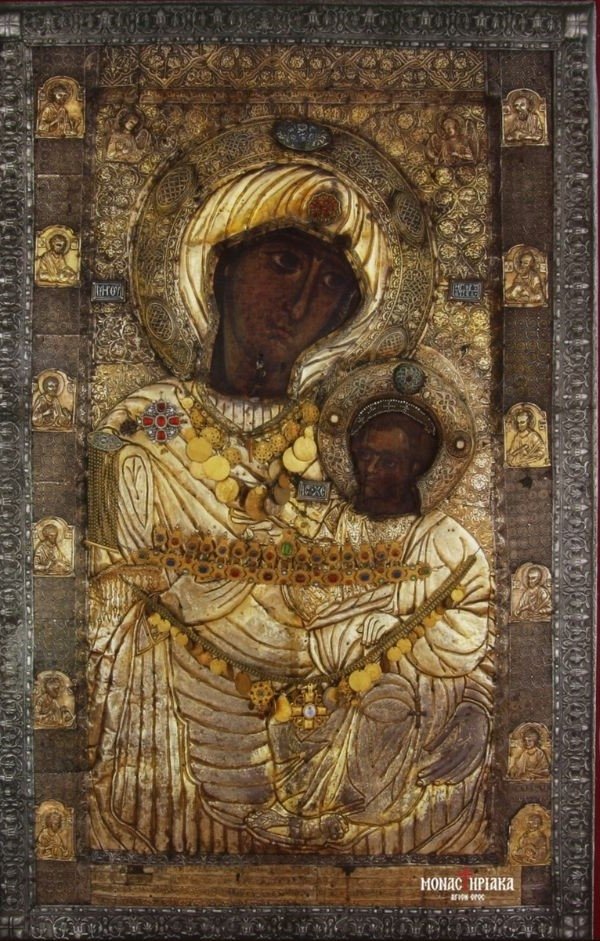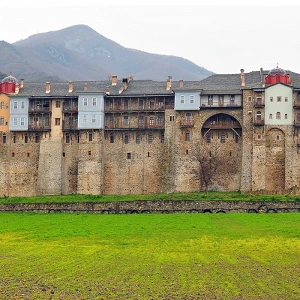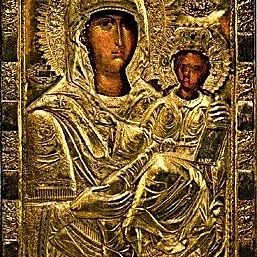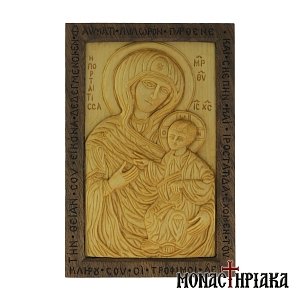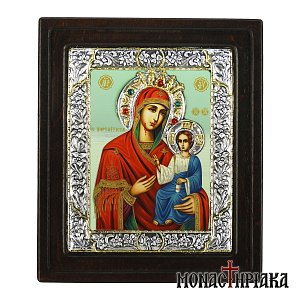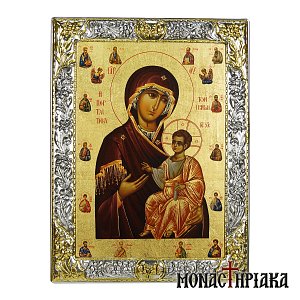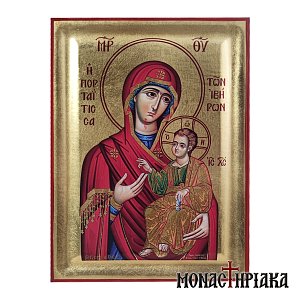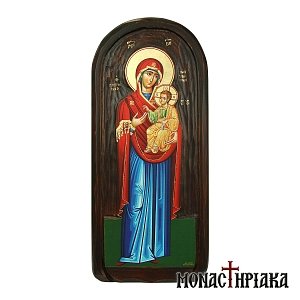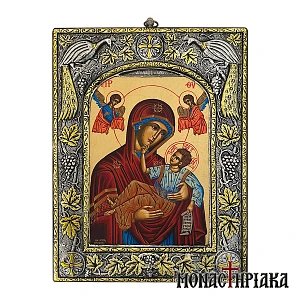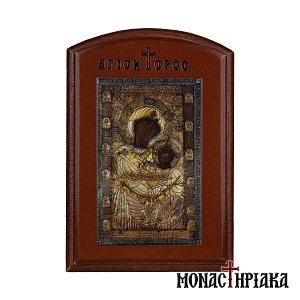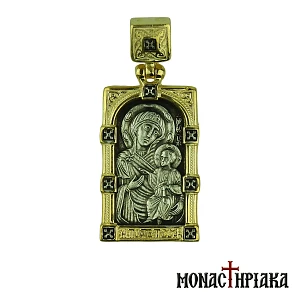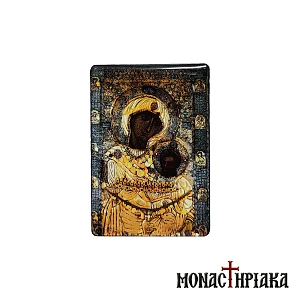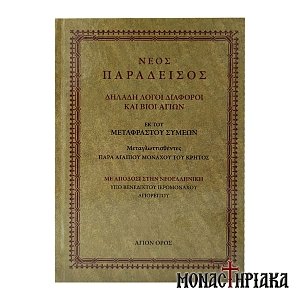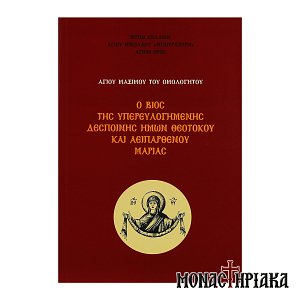One of the most significant and ancient icons of Mount Athos is the holy icon of the Virgin Mary Portaitissa. This holy icon stands out among others and is renowned for her miracles.
Where the icon of the Theotokos Portaitissa was located
According to Orthodox tradition, the icon of the Theotokos Portaitissa was kept in Nicaea, Asia Minor. It was placed in a private church by a devout woman and her son.
During the second iconoclasm, spies of the king discovered the presence of the icon and threatened the woman’s life unless she bribed them. The God-fearing woman promised to give them money, thus gaining one more day.
The miraculous event with the icon of the Theotokos Portaitissa
That same night, the woman prayed in front of the icon of Panagia Portaitissa and placed it in the sea, so that it might be saved from the hands of the iconoclasts. As she left it in the sea, she spoke the following words:
«Our Lady, you have the power to save us from the wrath of the King as well as to preserve your icon from drowning». Then, something truly marvelous happened!
The icon of the Theotokos Portaitissa remained upright and was headed westward, towards the Garden of the Theotokos. Then, the woman said to her son, «My child, for the love of the Theotokos, I am ready to die. You must leave and go to Greece».
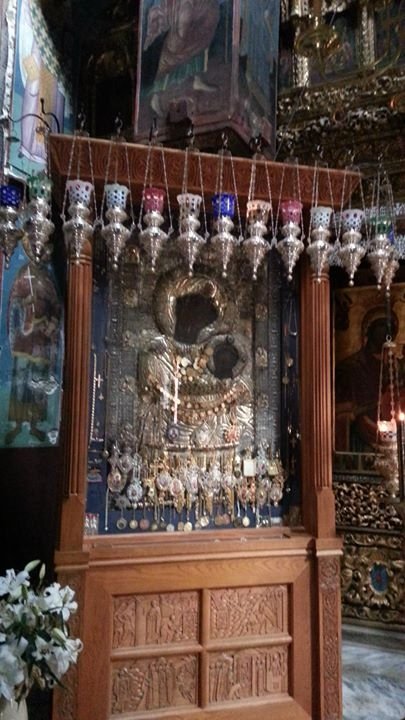
Find here: Icons with the Theotokos Portaitissa.
The icon of the Theotokos Portaitissa at Mount Athos
The woman’s son got ready and without delay departed for Thessalonica and from there to Mount Athos, where he became a monk. As a monk, he practiced asceticism in the place where the Monastery of Iviron was later established. He also informed the other monks of the monastery about the miraculous icon.
Find here the article: Holy Monastery Iviron: the history of the Monastery and the miraculous icon of Panagia Portaitissa
Years passed, and the monk rested in peace. When the establishment of the Monastery of Iviron was completed, the holy icon of the Theotokos Portaitissa appeared at the shore, distinguished by a luminous beam that began from the sea and reached to the heavens. When the monks saw the icon, they tried to approach it, but as they got near, it moved further away.
The miracle with Saint Gabriel
This continued day and night for several days. Without achieving anything, the monks went to the church to pray and beseech the Lord to grant the icon to their monastery. To one of the monks, Saint Gabriel, the Virgin Mary appeared and said:
«Tell the abbot and the other monks that I will grant you my icon to protect you. You will then enter the sea and walk upon the waves, so that all may understand my favor towards your monastery».
By the command of the Mother of God, Saint Gabriel walked upon the sea, which became solid under his feet. He retrieved the icon and brought it ashore. Since then, at that spot, a miraculous spring has emerged, through which the faithful are sanctified.
The transfer of the icon to the new chapel
After the incident of receiving the icon of Virgin Portaitissa by Elder Gabriel, the monks placed it in the Catholicon (main church) of the Monastery of Iviron, in a special shrine.
The next day, a monk went to light the candles and discovered that the holy icon was missing. It was not long before the icon was found and the monks placed it back in the special shrine.
The same event occurred three times until the Theotokos appeared to Saint Gabriel and said: «Tell the brethren not to disturb me. I did not come here to be guarded by you, but to protect you. Those of you who live a virtuous life on this Mount should hope in the mercy of my Son. For as long as my icon remains in your monastery, His grace and mercy will always overshadow you».
Thus, the monks built a chapel near the entrance of the Monastery and placed the holy icon of the Theotokos Portaitissa there. Since then, the Virgin Mary has protected the Monastery and served its needs, just as she had promised.
Find here: Hand Painted Byzantine Icon with the Virgin Mary Portaitissa.
The miracle of the icon of the Theotokos Portaitissa in Moscow
Around the year 1651 AD, the 365 monks of the Monastery were experiencing financial difficulties. Therefore, they asked the Theotokos to provide for their subsistence. The Virgin Mary fulfilled her promise of care and protection for the Monastery with the following miracle.
During the same period, the daughter of the Russian Tsar, Alexei Mikhailovich, was very ill. She suffered from paralysis in her legs and the doctors believed that she could not be cured.
One night, the Theotokos appeared in the dreams of the Tsar's daughter, giving her courage and promising to heal her. She said, «Tell your father to bring my icon, the Portaitissa from the Monastery of Iviron».
The next morning, when the daughter awoke, she relayed the command of the Ever-Virgin Mary to have the icon brought from the Monastery. However, fearing that the holy icon might not be returned to them, the monks sent a faithful replica with an honorable escort of four hieromonks.
When the miraculous icon of the Theotokos Portaitissa arrived in Moscow, everyone, from kings to common people, rushed to welcome and worship it. On the other hand, the princess lay in bed until she heard the joyful news. She then exclaimed, «What? The Theotokos is coming, and they left me here?».
The princess quickly got out of bed and literally ran to welcome the holy icon herself. The crowd was astonished to see her running, but the emotion reached its peak during the ceremony of prostration of the icon of the Theotokos.
The hieromonks presented the icon to the Tsar, saying: «Your Majesty»,the envoys said, «we offer this holy icon as a gift to the devout Russian nation».
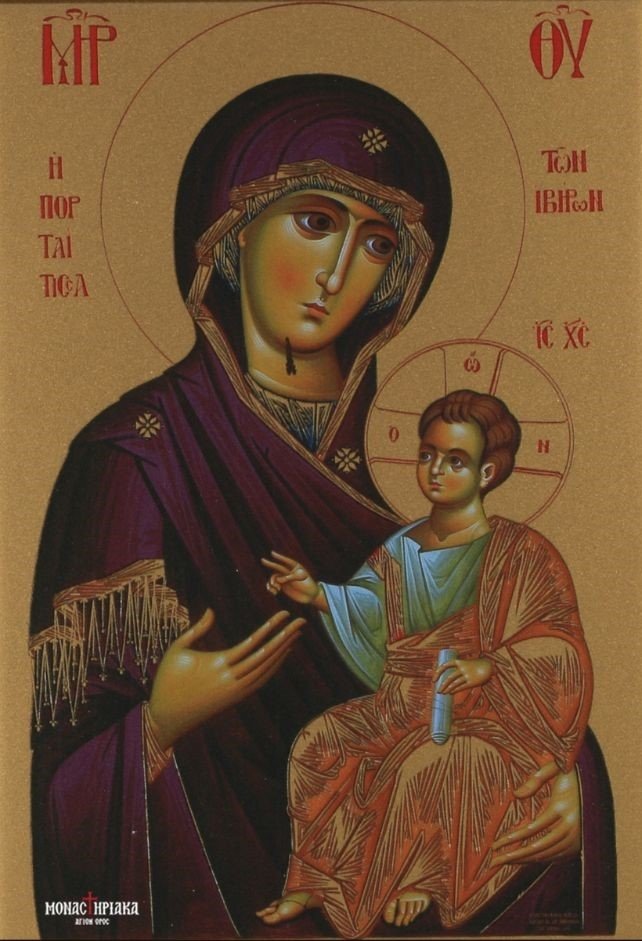
The granting of the Monastery of Saint Nicholas
The tsar, moved, responded, «Thank you. In gratitude, I grant you one of the finest monasteries in the capital, Saint Nicholas. Additionally, I will provide an annual allowance of 2,500 rubles, exemption from duties on all imports and exports from my country, as well as free transportation for your envoys».
The Monastery of Saint Nicholas remained under the ownership of the Monastery of Iviron until 1932 AD. Thereafter, it provided the monastery with substantial revenue, which could cover nearly all of its material needs.
When is the feast of the Virgin Mary Portaitissa
The Theotokos Portaitissa is honored annually on February 2nd, the same day of the Presentation of Jesus Christ the Candlemas.

